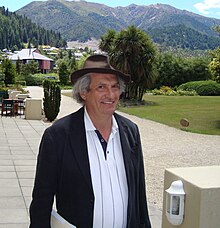Persi Diaconis
Persi Warren Diaconis (born January 31, 1945 in New York City ) is an American mathematician who mainly deals with statistics and probability theory. He was also known as a magician.
life and work
Diaconis comes from a family of professional musicians, and Diaconis also took violin lessons for nine years. a. at the Juilliard School . His mother is Polish and his father is Greek. He left school early at the age of 14 (he was just enrolled in New York City College ) to become a magician , at the invitation of the well-known magician Dai Vernon . Two years later, he was a professional magician, inventing his own tricks (some of his card tricks were published in Martin Gardner's column in Scientific American ) and teaching. According to his own statements, he switched to mathematics because he wanted to use William Feller's classic textbook on probability theory and statistics, but did not understand anything about it. He took evening classes at New York City College and graduated with a degree in mathematics in 1971. He was accepted into the Graduate Program in Statistics at Harvard University and received his PhD in 1974 under Dennis Hejhal ( Weak and Strong Averages in Probability and the Theory of Numbers ). Then he went to Stanford University , where he is still a professor today.
Twice (1992 and 1982) he received a MacArthur Foundation grant ( MacArthur Fellowship ). In 1990 he was invited speaker at the International Congress of Mathematicians (ICM) ( Application of group representations to statistical problems ) and also in 1998 in Berlin, where he gave a plenary lecture ( From Shuffling Cards to Walking around the Building: Introduction to Markov Chain Theory ). In 2012 he was awarded the Levi L. Conant Prize . He is a fellow of the American Mathematical Society and the American Academy of Arts and Sciences, and a member of the National Academy of Sciences and the American Philosophical Society .
Diaconis dealt e.g. B. with random matrices, Benfords law , random walks (Random Walks) to groups, and maps mixtures. He and Dave Bayer showed that at least seven “shuffles” (perfect mixes) are necessary to distribute 52 playing cards almost randomly (and for cards at least mixes). Diaconis was also active in the detection of manipulations in parapsychology and in the sphere of professional "gambling". With Joseph Keller he examined “fair” cubes (symmetrical and asymmetrical with any number of sides), and proved, for example, B. that there are no fair symmetrical cubes with five sides (but asymmetrical ones).
Sourav Chatterjee is one of his PhD students .
Fonts
- Group representations in probability and statistics. Institute of Mathematical Statistics, Hayward, 1988, ISBN 0-940600-14-5 .
- Theories of data analysis: from magical thinking through classical statistics. In: D. Hoaglin, Mosteller, Tukey (Editor): Exploring Data Tables, Trends and Shapes. Wiley 1985.
- Patterns in eigenvalues. Bulletin AMS 2003, Gibbs Lecture.
- Interview in Statistical Science , August 1986, p. 319
- From Shuffling Cards to Walking Around the Building: An Introduction to Modern Markov Chain Theory. ICM 1998.
- with Ronald Graham Magical Mathematics: the mathematical ideas that animate great magic tricks , Princeton University Press 2011 (the book received the Euler Book Prize in 2013 )
- with IM Isaacs: Supercharacters and superclasses for algebraic groups , Transactions AMS, Volume 360, 2008, pp. 2359-2392
literature
- Interview in Albers, Alexanderson: Mathematical People , Birkhäuser 1985.
Web links
- Homepage in Stanford
- biography
- Stanford News on Diaconis, Esther Landhuis Lifelong Debunker takes an arbiter of neutral choices
- by Diaconis
- on Diaconi's results for shuffling cards
- Press report on Diaconis at the ICM 1998
- Portrait Mathematician finds magic in numbers
Individual evidence
- ↑ After an article about him by Esther Landhuis in the Stanford News 2004, he wanted to check the odds of playing craps in a Caribbean casino that manipulated the dice
- ↑ Persi Diaconis in the Mathematics Genealogy Project (English)
- ↑ The Distribution of Leading Digits and Uniform Distribution Mod. 1. Annals of Probability, Vol. 5, 1977, pp. 72-81.
- ↑ D. Bayer, Diaconis: Trailing the Dovetail Shuffle to Its Lair. Annals of Applied Probability, Vol. 2, 1992, pp. 294-313. Diaconis, David Aldous: Shuffling Cards and Stopping Times. American Mathematical Monthly, Vol. 93, May 1986, p. 333. See also Rifle Shuffle at Math World
- ^ Statistical problems in ESP research. Science, Vol. 201, 1978, pp. 131-136. pdf ( Memento of the original from June 12, 2015 in the Internet Archive ) Info: The archive link was inserted automatically and has not yet been checked. Please check the original and archive link according to the instructions and then remove this notice.
- ^ Diaconis, cellar: Fair Dice. American Mathematical Montly, Vol. 96, April 1989, p. 337.
| personal data | |
|---|---|
| SURNAME | Diaconis, Persi |
| ALTERNATIVE NAMES | Diaconis, Persi Warren (full name) |
| BRIEF DESCRIPTION | American mathematician |
| DATE OF BIRTH | January 31, 1945 |
| PLACE OF BIRTH | New York City |


